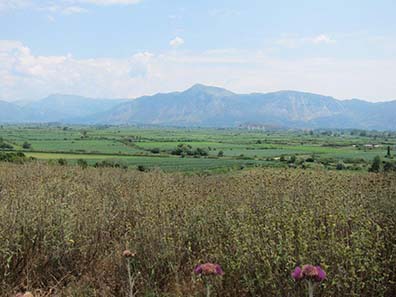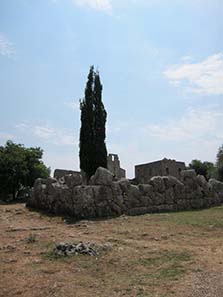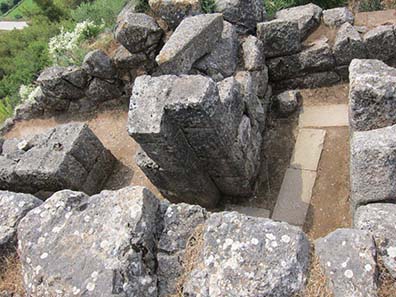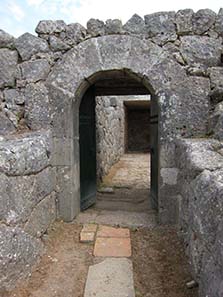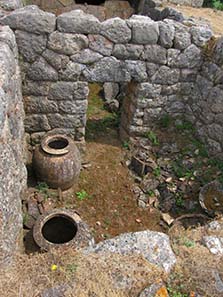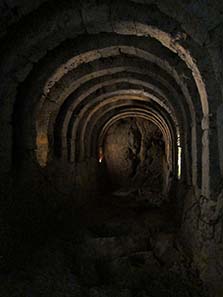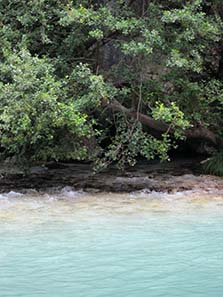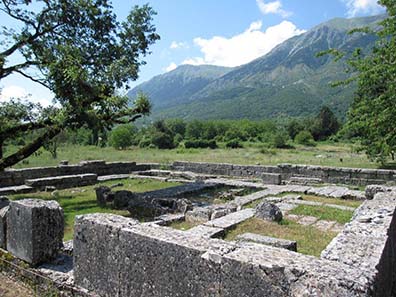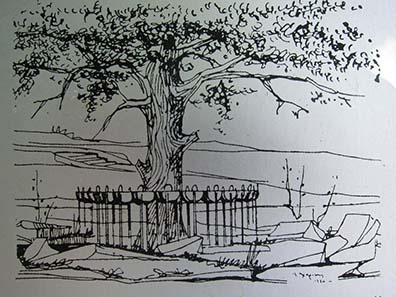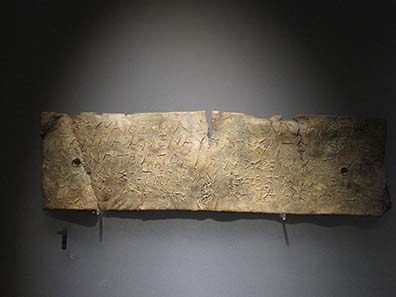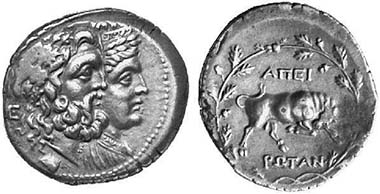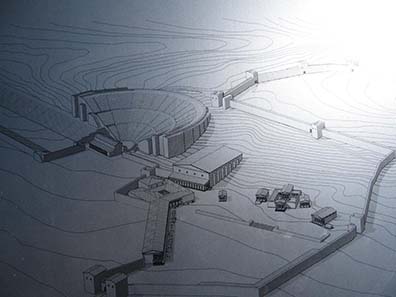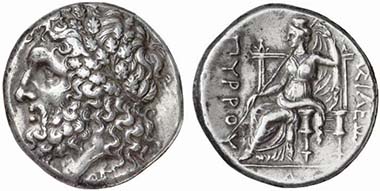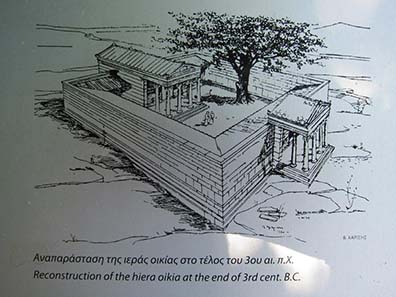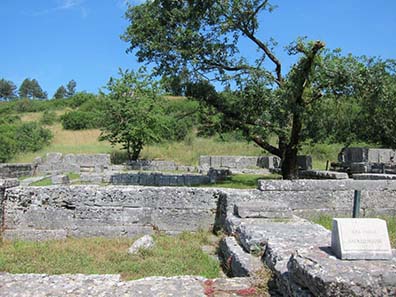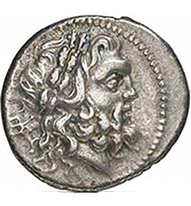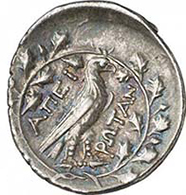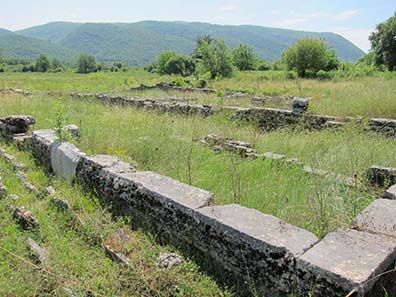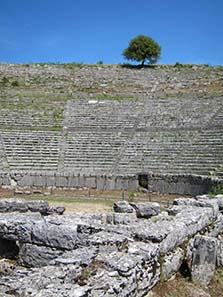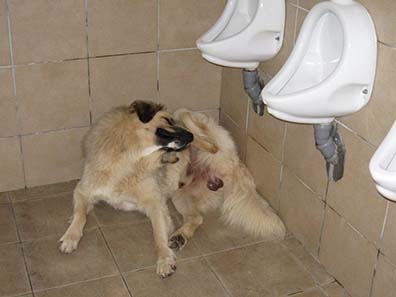by Ursula Kampmann
June 30, 2011 – During the second stage of Ursula Kampmann’s journey to Greece, she wades through icy-cold Acheron, River of the Dead, descends to the realm of the dead and visits the oak of Dodona. There she introduces us to the world of ancient oracles…
Day 5, June 14, 2011, At the gateway to the Underworld
A river crosses the Epirus which was known to all Greeks – the Acheron River, border between the living and the dead, which Charon uses to transport the recently deceased on his bark. According to poets and archaeologists, the gateway to the Underworld is located in Epirus. The poets have described the Nekromanteion, an oracle where the Greeks could contact their dead. The archaeologists firmly believe that they have found the very Nekromanteion at the mouth of the Acheron River.
The Nekromanteion is situated in a fructiferous alluvial plain at the foot of mountains. Photograph: KW.
Getting there is easy. The Nekromanteion is a well-signposted and well-frequented site making for a nice change to sun-bathing. And who doesn’t get goose bumps when there is talk of contacts with the dead? By the way, Herodotus already was aware of the Nekromanteion. He made it a setting of an episode that put the tyrant Cypselus (whose son had founded near-by Ambracia) in a very bad light. His wife Melissa who had just passed away had hidden a treasure whose location she couldn’t tell her husband anymore. Hence, Cypselus asked the Nekromanteion where to look. Melissa, however, was angry. Since her costly clothes hadn’t been burnt with her, she was forced to feel cold in the Underworld now. To convince Cypselus of her telling the truth she reminded him that “he had put the bread in the cold oven”, i.e. that he had had… – how to put it inoffensively? Well, you surely know.
Cypselus was immediately convinced that the Nekromanteion spoke with the deceased’s voice. He had all women come to the palace and made sure they took off their clothes. His plan was to get as many clothes – without spending any money – as it took to satisfy his wife. And he was successful: when he asked a second time, Melissa told where to find the treasure.
Entrance to the Nekromanteion. Photograph: KW.
Surely not every visitor of the Nekromanteion came for such specific matters like Cypselus. After all, the death of a person often comes as a surprise, so much that hadn’t been said – a place where that could be made up for surely was a comfort to many a people. It has to be considered that in antiquity the spheres of the living and the dead weren’t regarded clearly separated. Time and again the big heroes of tales and legends crossed that border.
Continuity of place: the Nekromanteion was discovered under a cemetery church of the 18th century. Photograph: KW.
Particularly impressive is the narration of the Odyssey telling of how Odysseus approached the dead. The following words may well reflect what was actually happening at the Nekromanteion:
“…I [Odysseus] drew my sharp sword from beside my thigh,
and dug a pit of a cubit’s length this way and that,
and around it poured a libation to all the dead,
first with milk and honey,
thereafter with sweet wine,
and in the third place with water,
and I sprinkled thereon white barley meal. (…)
I took the sheep and cut their throats over the pit,
and the dark blood ran forth.
Then there gathered from out of Erebos
the spirits of those that are dead (…).
These came thronging in crowds about the pit
from every side, with a wondrous cry;
and pale fear seized me.
Then I called to my comrades and bade them flay
and burn the sheep that lay there slain with the pitiless bronze,
and to make prayer to the gods (…).
Perhaps this conduct mirrors a similar ceremony like the one performed by visitors to the Nekromanteion still centuries later.
Entrance to the Nekromanteion. Photograph: KW.
First, the visitors walked a narrow corridor. To the left, there were storage rooms and a chamber for ritual cleansing. We have to imagine all rooms roofed, dark, lit by torches alone which may well have been equipped with substances that influenced the visitors’ perception.
“Maze”. Photograph: KW.
At some point, the visitor surely had lost his bearings for the roofed corridor didn’t go all straightforward but meandered quite a bit.
Entrance to the central cult room. Photograph: KW.
Finally, the ones looking for aid arrived at a big bronze door locking the entrance to the central cult room.
The central cult room. Photograph: KW.
It was here where the most important ceremonies were conducted. Back then, no light came in from outside. The mystical atmosphere, hallucinogenic substances, and the prayers of the priests – all that prepared the believer to receive the voices of the dear dead.
Storage rooms for votives? Photograph: KW.
In antiquity, oracles carried out the same duty as present-day psychotherapists: they assisted the people in making a decision or accepting considerable blows as inevitable will of the gods and hence to go on living. The believers paid back with lavish donations. Perhaps these were stored in the rooms adjacent to the central cult room.
Basement. Photograph: KW.
Some archaeologists believe that the priests got involved to increase the willingness to donate, and made sure, by applying stage hoists, false bottom and speaking tubes, that even a doubting Thomas would be able to hear voices.
Well, that is what some archaeologists believe. Others say that the true Nekromanteion haven’t been discovered so far, that the excavations only revealed an estate whose peculiar architectonic layout may well be explained with the requirements of stockpiling.
I, for my part, firmly believe in having visited the Nekromanteion. For one thing, it is much more romantic than an ordinary estate; and, for another thing, three snakes have actually shown themselves in the holy district. Yet it is common knowledge that snakes are the messengers to the Underworld, isn’t it?
River of the Dead: Acheron. Photograph: KW.
Be that as it may, a relatively recent tourist attraction is the springs of the Acheron which are well-signposted so that they can easily be found.
Like I said, according to tradition, the Acheron was one of five rivers of the Greek Underworld and may be called synonymously with Hades. The passage to the realm of the dead is located here – just like the Styx which cannot be precisely located.
The springs of Acheron. Photograph: KW.
Even though the two true headstreams of the Acheron rise from a point higher in the mountains, antiquity thought the freshwatersprings near the small village of Glyki entrance to the Underworld. It got its name from an old saint’s legend. According to that, the water of the Acheron, being an Underworld river, was poisonous. A saint, however, took pity on the people and made the poisonous water sweet –“glykos”.
The bubbling springs still give the impression of coming straight from the heart of the earth.
Acheron. Photograph: KW.
It is icy cold.
Acheron. Photograph: KW.
Greetings from the entrance to the Greek Underworld!
Day 6, June 15, 2011, Where the oak proclaims the will of Zeus
As the Nekromanteion has showed us: there were many oracles in the ancient world. The one at Delphi was simply the most famous. Today, we visit an oracle in the North which was at least as important: Dodona.
Sanctuary for Zeus in Dodona. Photograph: KW.
Dodona is picturesquely situated right in an impressive mountainous area. Thanks to the “Egnatia”, it is no problem at all to get there. There is even a signpost indicating the excavation site located only a few kilometers away from the freeway. Already Homer mentions the oracle at Dodona again and again, and a variant of the Argonautica tells that Athena implemented a piece taken from the Sacred Oak into the Argo to vest prophetic powers in the ship.
The Sacred Oak. Photograph: KW.
The Sacred Oak was the center of Dodona, which is one of the many Greek sanctuaries without a ‘real’ temple. Priestesses, called Peleiades (= doves), interpreted the rustling of the oak as well as the call and the flight of the doves nesting there to answer the inquiries of the believers. Later, other procedures were added, such as the divination by lot and the interpretation of the stroke of a gong.
Lead tablet with an inquiry to the oracle. Ioannina Museum. Photograph: KW.
The inquiries were written on lead tablets of which a great number were unearthed during the archaeological excavation. They are exhibited not on-site but at the Archaeological Museum Ioannina. They testify to all too human worries. Like, for example: “Kleoutas asks Zeus and Dione if stock farming may be advantageous and profitable.” “Lysanias asks Zeus and Dione whether or not he is the father of the child Nyla is expecting.” Nikokrateia likes to know which god to sacrifice to in order to convalesce and to get rid of her illness.” “The city of Mondaiatai asks Zeus Naios and Dione regarding the money of Themisto if she can afford it and if it is right to grant her a loan.”
Koinon of Epirus. Didrachm, 234-168. Bust of Zeus of Dodona and of Dione. Rev. Attacking bull r. Franke 4. From auction Künker 94 (2004), 774.
Apart from Zeus, a number of other deities were worshipped in Dodona. The most important one was Dione who most possibly had her origin in an old cult for an earth goddess.
Map of the sanctuary. Photograph: KW.
One of the many buildings in close proximity to the Sacred House for Zeus is attributed to her. Since she was regarded mother of Aphrodite researchers interpret the remains of another small temple as a precinct in her honor.
Pyrrhos in Lokroi Epizephyrioi (Bruttium). Head of Zeus of Dodona. Rev. Enthroned Dione l. From auction Numismatik Lanz 132 (2006), 39.
Until the early 4th century, the oracle was under influence of the Thesprotes, a tribe who settled between Ioannina and Dodona. That changed under Pyrrhus. Aided by the Ptolemies, he managed to re-conquer his empire of Epirus in 297. He made Dodona the central sanctuary of his empire. He consulted the oracle before he departed for his big operation in South Italy.
Reconstruction of the Sacred House of Zeus. Photograph: KW.
The layout of the existing Sacred House for Zeus was initiated by Pyrrhus. He had a high wall built – on its inner side open to a portico –, surrounding the prophesying oak tree and the small treasure house.
The Sacred House with the oak tree. Photograph: KW.
The oak presently standing right in the Sacred House naturally isn’t the original one. The location, however, is right since the archaeological excavation discovered a soil mark that can only be caused by a big root stock lifted. That seemed to have occurred in A. D. 391 when, in the process of the destruction of the sanctuary by fanatic Christians, the Sacred Oak wasn’t only felled but, in a symbolic action, was eliminated together with it root stock.
Koinon of Epirus. Drachm, around 210 B, C. Head of Zeus r. Rev. Eagle on thunderbolt, surrounded by an oak wreath. Franke 32-91. From auction Gorny & Mosch 191 (2010), 1394.
After Alexander, the son of Pyrrhus, had died, the politicians of Epirus founded a koinon whose assembly and officials held meetings in Dodona and Phoinike. Several buildings in Dodona testify of the political activities of the coalition.
The Prytaneion. Photograph: KW.
One example is the Prytaneion where the Prytaneis as highest executive directed the affairs of the Epirote League. Archaeologists have identified the remains opposite the Prytaneion as Bouleuterion where the Boulé, the council of the League, convened.
The theatre of Dodona. Photograph: KW.
The assembly originally held meetings in the theatre of Dodona, built by Pyrrhus. After all, most ancient theatres not only served cultural but political purposes as well. Today, very impressive theatre performances can be viewed here in summer. The theatre is the most prestigious of the ruins of Dodona that take roughly one hour to visit. They are easily accessible since EU and Greek government have invested money to the result that tourists not only enjoy the luxury of a well-paved parking lot and a small café…
Making good use of the shade. Photograph: KW.
…but of well-maintained toilets as well which not only humans derive benefit from.
That’ll do for now. Don’t miss the report coming up next week. We’ll visit Katerini Liampi in Ioannina and proceed to the center of power of Philipp II of Macedon.
You can read all other parts of this diary here.




